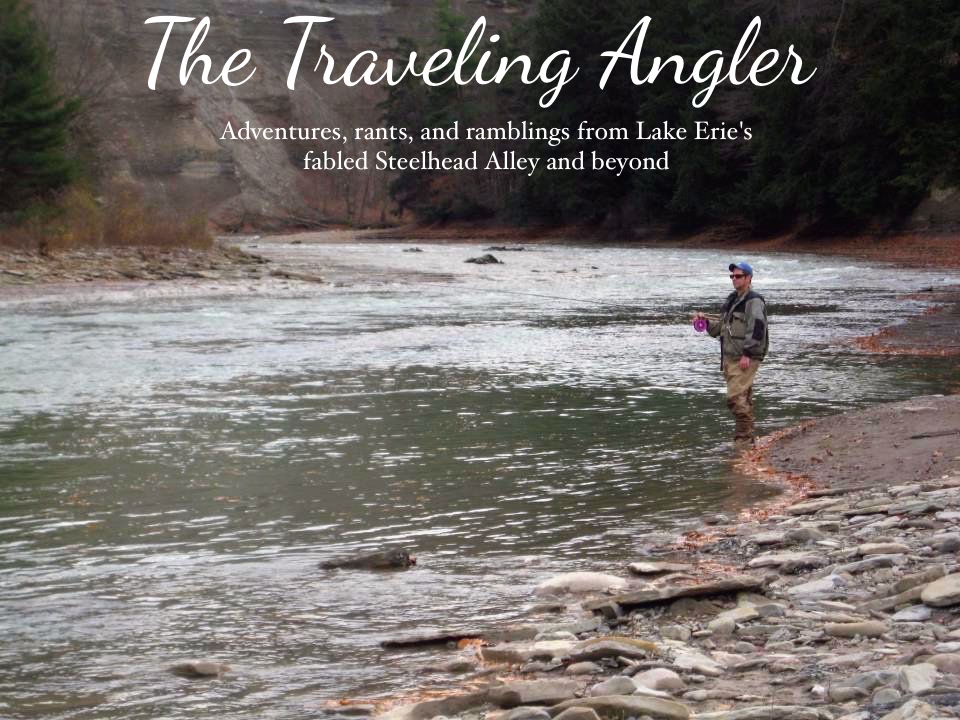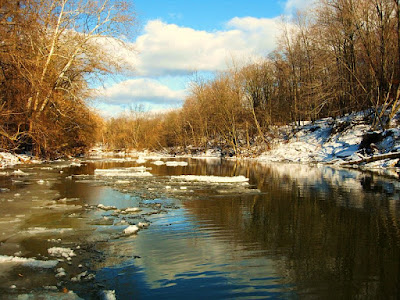Fishing for steelhead in the winter separates the boys from the men. Frigid temperatures can test even the hardiest of steelheaders. We have to deal with side ice, slush, and riving through lake effect snows. We can wear the warmest of clothing, only to succumb to the elements. Working the pools and holes can be a long drawn out process that can test the patience of most anglers. But you can be rewarded if you know what your doing and willing to put the work in.
Location, location, location
When water temperatures get into the low 30s, a steelhead's metabolism is almost catatonic. They'll seek places in the river where they'll get relief from the current. That's where reading water is invaluable. When I fish during cold periods, I look for the slowest flowing parts of a river. Places I'll fish will be the lower sections close to the lake if ice isn't an issue. Here the rivers tend to be wider, more flat, and a little deeper. Any structure at the bottom such as rocks and lumber will be utilized by fish to conserve energy. Other places will be the wide bends and the tail end of pools. On bends, fish will hang off the main current, so watch the speed of the bubble line. At the tail end of pools, fish prefer to be there as the current is deflected up and away. Other areas to target include along shale ledges and drop off in pools that are not deep. If side ice is present, drift a float as close as possible as fish often use the ice as cover.
Time of Day
When night time temperatures get into the low 20s or teens, I'll sleep in. The reason why is slush. Fishing in slush is pointless and quite honestly a waste of time. At times it can be so thick that it's impossible to fish. The best thing to do is go later in the day, especially on days when the sun is out. As the day progresses, the sun's rays warm the water. Gradually the chunks of slush get smaller and smaller. By mid to late afternoon, it's usually all gone. The other advantage of going later is the water temperature might go up a couple degrees. That little bump could the difference whether a fish is willing to move to take your bait or fly. The added bonus is a lot of the best spots will be vacant as the majority of anglers that tried to fish in the morning are gone.
Cut Back on Bright Colors
I've heard some people say that bright colors are effective on steelhead in cold water because "bright" colors get their attention. There's been plenty scientific studies that show fish will react in certain light and background conditions. While it's true that bright colors are more effective in stained conditions and natural colors in clear water. It depends what river I'm fishing on. The Grand is a river that runs off color the majority of the time. But in the winter when the clay and mud bank freeze up, the water will turn to a tea color. In water like that I'll use a chartruese or pink colored sac. The other rivers run much clearer and in the deeper sections the water takes on a greenish hue. In conditions like that I'll use white, blue, peach, or red as they're more subtle. The same can be said about jigs as my favorite color is simple 1/32 oz white one.
Getting Jiggy With It
The majority of steelheaders will use sacs exclusively. During cold weather a jig can be deadly. I carry a wide variety of jigs of different colors. The best color for me are white with a red or pink head. Another favorite pattern is a white zonker. The marabou breathes enough life that a lethargic steelhead might be tempt to take it.
Bundle Up
Winter along the Steelhead Alley isn't as severe as the Northern Great Lakes states, but it still can get cold. Wearing the right type of clothing is essential. When I fish during the winter, I layer my clothing. All of my clothing consists of fleece and polyester. Your clothing should also have the ability to wick away any moisture. For a shirt I wear a compression long sleeved shirt. For my legs I wear a compression long johns and over that I are fleece pants. For my feet I wear a pair of polypropylene socks and over that wool socks. Make sure that you have enough room in your boots. Because if your boots are too small, your feet won't be able to move blood and that's when your feet start to get cold. That's why I buy boots a couple sizes bigger to accommodate socks. For a jacket I wear a fleece one and over that I wear another jacket made of goretex. Head gear is always a toque or balaclava. I'll also bring along a pair of gloves. Even though I never wear them while I'm fishing, I'll put them on when I walk from spot to spot. Another important item that anglers forget is bringing a small towel. Towels come in handy to wipe your hands when releasing a fish. Nothing is worse than cold fingers, because you need them to tie knots. In my jacket is where I carry a couple heat packs. They give off plenty heat to get those fingers functioning again.
Have Patience
You'll need a lot of it when it because these fish won't budge as you'll need to practically put it on their nose. That means working the section and having to try different colors or presentations. You might have also move around to find where fish are holding.



